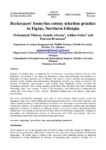Por favor, use este identificador para citar o enlazar este ítem:
http://www.alice.cnptia.embrapa.br/alice/handle/doc/1043917Registro completo de metadatos
| Campo DC | Valor | Lengua/Idioma |
|---|---|---|
| dc.contributor.author | TILAHUN, M. | pt_BR |
| dc.contributor.author | ABRAHA, Z. | pt_BR |
| dc.contributor.author | GEBRE, A. | pt_BR |
| dc.contributor.author | DRUMOND, P. M. | pt_BR |
| dc.date.accessioned | 2016-04-25T11:11:11Z | pt_BR |
| dc.date.available | 2016-04-25T11:11:11Z | pt_BR |
| dc.date.created | 2016-04-25 | pt_BR |
| dc.date.issued | 2016 | pt_BR |
| dc.identifier.citation | Livestock Research for Rural Development, Cali, v. 28, n. 5, May 2016. | pt_BR |
| dc.identifier.issn | 0121-3784 | pt_BR |
| dc.identifier.uri | http://www.alice.cnptia.embrapa.br/alice/handle/doc/1043917 | pt_BR |
| dc.description | Selection of colonies plays an important role for successful harvesting of desired products from honeybees. The purpose of this study was therefore to assess local knowledge and experience of beekeepers in Tigray regional state of Ethiopia with regard to colony selection and management practices during purchase and multiplication. Respondent selection was carried out based on the existing conventional agroecological zones namely Dega (highland), Kolla (lowland) and Weinadega (midland). Four woredas (districts) from Dega zone, and three from each of Kolla and Weinadega zones were sampled. A total of 185 beekeepers were interviewed to understand the criteria they were using to select colonies. Preference ranking data were indexed using linear programming. The result indicated that beekeepers were using six local selection criteria namely worker bee population, body color, comb building direction, aggressiveness, honey yield history and age of the colony ordered according to their preference rank from 1 to 6. Beekeepers understood that selection of honeybee colonies was important because productivity, management easiness and agroclimatic adaptation of colonies are different for different colonies. As a result colonies with dominant black colored bees were chosen as first priority for their merits of better honey productivity, tolerance to absconding and multiplication easiness in Weinadega and Kolla agroecologies. However, red/yellowish colored bees were preferred in Dega agroecology. | pt_BR |
| dc.language.iso | eng | eng |
| dc.rights | openAccess | eng |
| dc.subject | Tigray | pt_BR |
| dc.subject | Etiópia | pt_BR |
| dc.subject | Colonias de abejas mielíferas | pt_BR |
| dc.subject | Programación lineal | pt_BR |
| dc.subject | Apicultores | pt_BR |
| dc.subject | Criterio de selección | pt_BR |
| dc.subject | Optimización de los sistemas | pt_BR |
| dc.title | Beekeepers' honeybee colony selection practice in Tigray, Northern Ethiopia. | pt_BR |
| dc.type | Artigo de periódico | pt_BR |
| dc.date.updated | 2017-06-19T11:11:11Z | pt_BR |
| dc.subject.thesagro | Apicultura | pt_BR |
| dc.subject.thesagro | Pequeno produtor | pt_BR |
| dc.subject.thesagro | Abelha | pt_BR |
| dc.subject.thesagro | Colônia | pt_BR |
| dc.subject.thesagro | Seleção | pt_BR |
| dc.subject.thesagro | Método de otimização | pt_BR |
| dc.subject.thesagro | Programação linear | pt_BR |
| dc.subject.nalthesaurus | Apiculture | pt_BR |
| dc.subject.nalthesaurus | Beekeepers | pt_BR |
| dc.subject.nalthesaurus | Honey bee colonies | pt_BR |
| dc.subject.nalthesaurus | Selection criteria | pt_BR |
| dc.subject.nalthesaurus | System optimization | pt_BR |
| dc.subject.nalthesaurus | Linear programming | pt_BR |
| riaa.ainfo.id | 1043917 | pt_BR |
| riaa.ainfo.lastupdate | 2017-06-19 | pt_BR |
| dc.contributor.institution | Mohammed Tilahun, Mekelle University; Zenebe Abraha, Mekelle University; Addisu Gebre, Mekelle University; PATRICIA MARIA DRUMOND, CPAF-Acre. | pt_BR |
| Aparece en las colecciones: | Artigo em periódico indexado (CPAF-AC)  | |
Ficheros en este ítem:
| Fichero | Descripción | Tamaño | Formato | |
|---|---|---|---|---|
| 25986.pdf | 237,04 kB | Adobe PDF |  Visualizar/Abrir |









